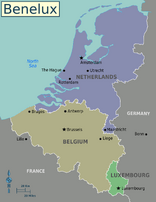The Benelux Economic Union is an customs, economic and monetary union in Western Europe comprising three neighboring countries, Belgium, the Netherlands, and Luxembourg. These countries are located in northwestern Europe between France and Germany. The Union's name is formed from the beginning of each country's name.
Origins of Benelux[]

Map of Benelux Economic Union (Belgium, Netherlands and Luxembourg)
The origins of the Benelux Economic Union are in the customs and economic cooperations treaties signed between Belgium and Luxembourg after World War I. After the economic crisis of 1932 and collapse of the Conference on European Union (1934), talks between Belgium, Luxembourg and the Netherlands began in order to incorporate the three countries in customs unions and further economic integration. The result was the Benelux Treaties (Customs Regulation Treaty, Treaty Regulating Foreign Trade, Monetary Agreement Treaty, and Common Institutions and Cooperation Treaty). These treaties where approved between 1935-1936. The treaties establishing the Benelux are limited to a period of 50 years.
Rights of Citizens and member states[]
As stated in the Common Institutions and Cooperation Treaty, all citizens and residents of Benelux states have the same conditions of:
a) freedom of movement, sojourn and settlement;
b) freedom to carry on a trade or occupation, including the rendering of services;
c) capital transactions;
d) conditions of employment;
e) social security benefits (health and social welfare);
f) taxes and charges of any kind;
g) exercise of civil rights as well as legal and judicial protection of their person, individual rights and interests.
The Common Institutions and Cooperation Treaty also states that being an intergovernmental organization it requires that national parliaments vote or approve common legislation, and have wide powers to ratify and reform the Benelux Treaties. Also the judiciary of member states elects and names the judges of the Arbitration Court.
Economical development[]
The Benelux Treaties pooled the iron and coal resources between the three states. The main economic success was the coal and steel production. It increased during the following yeas and promoted postwar recovery. It embraced the industrial conversion of post war heavy and light manufacturing sectors. It also enabled the development of a chemical and pharmaceutical industry.
Postal and transport rates are standardized, and so are banking services, between the member states. In 1940 a common accounting unit was created, the Benelux florin/florijn (Bƒ)
It also promoted investment in the territories of the Commonwealth of States and colony of Belgian Congo. The later becoming a major pole of investment and development after the Société Générale de Belgique was broken up in 1940 by order of the Arbitration Court. The Congo Agreement (1941) reaffirmed Benelux's free movement of workers, capital, services, and goods in the Belgian Congo.
Institutions of Benelux[]
The Benelux Treaties established are:
- Coordinating Council, integrated by the heads of governments and the Secretariat. It is the chief political entity and representation of the Benelux. It meets every six months.
- Committee of Ministers;
- Consultative Interparliamentary Council, integrated by representatives of the three parliaments. It consists of 49 members: 21 Members of Parliament from Belgium, 21 from the Netherlands and seven from Luxembourg;
- Administrative Council for Customs Regulations;
- Administrative Council for Trade Agreements;
- Administrative Council for the regulation of foreign trade; and
- Arbitration Court, composed of judges from the highest courts of the three States
The Treaties established that additional conventions or treaties can be proposed by the Coordinating Council or Council of Ministers, and approved by the national parliaments so they can become national law.
Membership[]
The full members countries are:
Associated agreements states:
| Member state | Capital | Area (km2) | Population | Main languages | Currency | Status |
|---|---|---|---|---|---|---|
| Leopoldvill | 2,344,858 | French, Dutch and Lingala (lingua franca) | Congolese franc | Colony of Belgium | ||
| Batavia (Jakarta) | 1,938,314 | Dutch, Indonesian and Javanese | Nederlands-Indische gulden | Member of Commonwealth of States | ||
| Willemstad | 980 | Dutch, Papiamento and English | Netherlands Antillean guilder | Member of Commonwealth of States | ||
| Paramaribo | 163,821 | Dutch and Sranan Tongo | Surinamese guilder | Member of Commonwealth of States |
| ||||||||||||||||||||||||||

